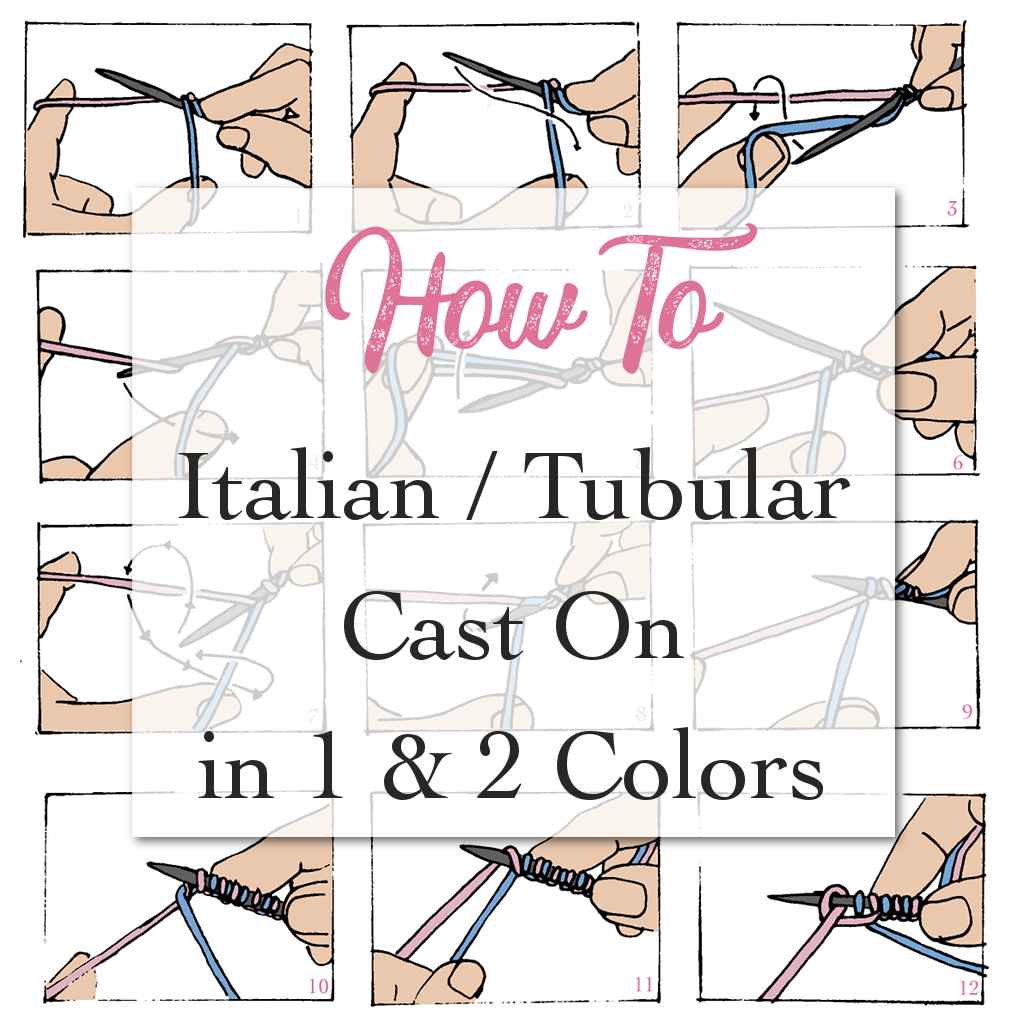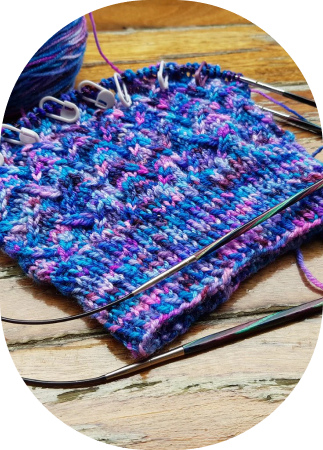
How to Do a Tubular or Italian Cast On

When to Use a Tubular or Italian Cast On?
Use a tubular cast on whenever you need a stretchy cast on edge. I use a 2 Color Italian Cast On when I'm brioche knitting, which gives me a cast on edge that will stretch and move the same amount as my brioche. I also use a tubular cast on when knitting raglan sweaters which allows for plenty of stretch in the neck when pulling my head through. Tubular cast on is especially great for turtlenecks.
Two Color Italian Cast On
Begin by tying your two colors together in a knot. Hold the knot along the top of your needle with your right hand. With your left hand, create a 'V' Shape with the yarn, wrapping the lighter yarn around your index finger, and darker yarn around your thumb, and holding the yarn in the remaining three fingers against your palm in order to keep tension on the yarn. The needle is angled upward between the two strands. (1)
Cast on the Knit Stitch (Typically the Light Strand)
Twist the tip of your needle up, over, around the outside of the dark yarn, bring the needle up in between the two strands (2), around the outside of the light strand (3), and then below both strands (4). Tilt the needle back up, and pull both strands downward to tidy up your new cast on stitch (5&6).

Cast on Purl Stitch (Typically the Dark Strand)
Twist the tip of your needle around the back of the light strand, and under both strands (7). Bring the needle down between the two strands, under, up and around the outside of the light strand (8), pull both strands downward to tidy up your new cast on stitch (9).

Notes for using Italian Cast on for Brioche
Repeat the above steps, until you've cast on the required number of stitches- this should be an odd number beginning and ending with a Knit (Light) stitch (10). On the last stitch- if you were to release the yarn it would just come off (11)so we need to make a half hitch to keep that stitch on the needle.
Hold the dark yarn in your right hand to hold the stitches in place, with your left hand pick that last light stitch off the needle and rotate it 180 degrees and place it back on the needle so that it traps the light color strand when you pull it snug (12).
Note: When you're working this way the beginning 'knot' does not count as a stitch and it will be dropped off the needle when you do your first set up row (13).

One Color Italian Cast On with Lifeline (For Raglans)
Note: When doing a Tubular Cast on for sweaters, I always use a needle 3 sizes smaller than the ribbing needle so that the cast on edge stays neat and small.
When using Italian cast on for my raglan sweaters it's important to be able to cast on a large amount of stitches (and be able to join it in the round without a twist). Since the cast on is composed fo twiststed threads, it can get a bit hectic when working with such large stitch, and as you get into the rhytm of the cast on, when interrupted, it can also be difficult to remember whether you've just cast in a knit or purl. In order to keep track of how many stitches I have, and prevent them from twisting I like to use a lifeline in a contrasting color and a smooth yarn that can pull out easily, which weaves back and forth between the stitches.
I prefer to weave my lifeline every 2 stitches.
Get Set Up
Begin by setting up your yarn as you would for a long tail cast on. Tie a slipknot in your yarn which incorporates your lifeline strand into the knot. Place the slipknot on your needle which will act as your first stitch.
Hold the slipknot on your needle with your right hand, and wrap the lifeline yarn around your right index finger in a English style 'throw' ready position. With your left hand, create a 'V' Shape with your working yarn, wrapping the yarn around your index finger, and thumb, holding the yarn in the remaining three fingers against your palm in order to keep tension on the yarn. The needle is angled upward between the two strands.

Because the slipknot is the first stitch, I typically begin with the 'Purl' Stitch when casting on for my raglans. That way when I join in the round I am set up with my K1, P1 Rib.
Cast on Purl Stitch (Rear Strand)
Twist the tip of your needle around the back of the rear strand, and under both strands. Bring the needle down between the two strands, under, up and around the outside of the rear strand, pull both strands downward to tidy up your new cast on stitch.
Lifeline: With your right index finger pass the lifeline under the needle from back to the front of your work.

Cast on the Knit Stitch (Forward Strand)
Twist the tip of your needle up, over, around the outside of the forward yarn, bring the needle up in between the two strands, around the outside of the rear strand, and then below both strands. Tilt the needle back up, and pull both strands downward to tidy up your new cast on stitch.

Cast on Purl Stitch (Rear Strand)
Twist the tip of your needle around the back of the rear strand, and under both strands. Bring the needle down between the two strands, under, up and around the outside of the rear strand, pull both strands downward to tidy up your new cast on stitch.
Lifeline: With your right index finger pass the lifeline under the needle from the front to the back of your work.

Continue like this passing the lifeline back and forth after you complete your purl stitch.
Notes on Italian Cast on for Raglans (Joining in the Round)
Repeat the above steps, until you've cast on the required number of stitches- this should be an even number of stitches. Simply join in the round as you usually would, being mindful to change back you your ribbing needle size.
Note: When you're working this way the beginning 'slipknot' counts as your first stitch.

To see the Italian Tubular Cast On in action, watch our video below:

